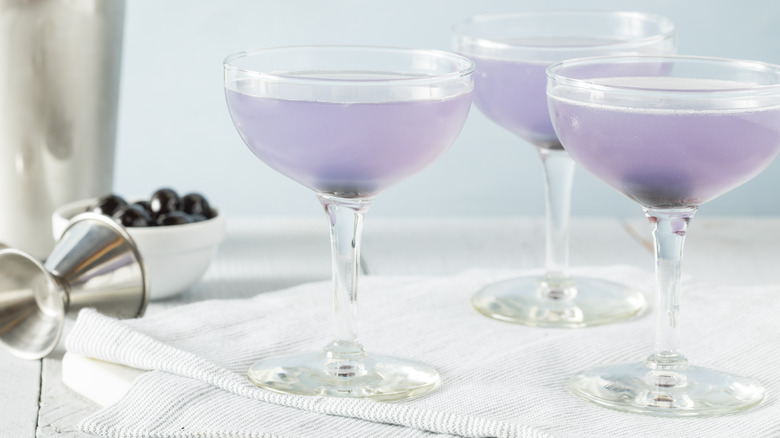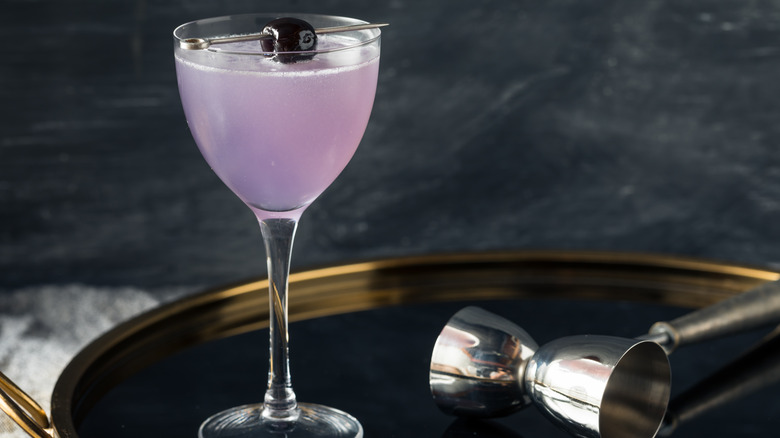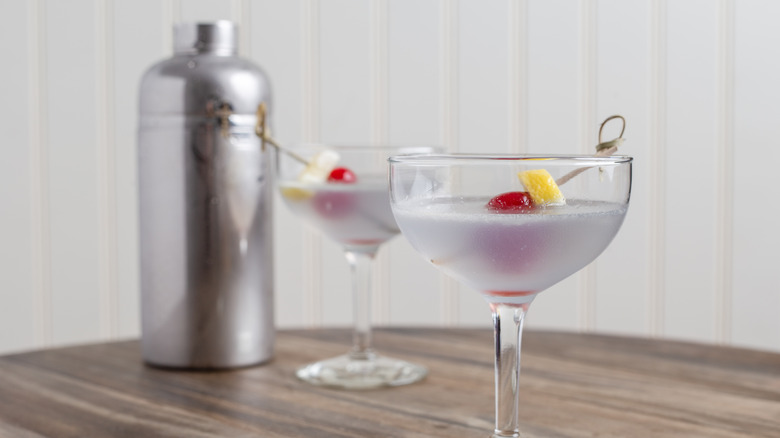Aviation Is The Flowery Cocktail That Was Almost Forgotten
Cocktail crazes ebb and flow. Take, for instance, the Cosmopolitan. It was already on the upswing in the 1990s when it got a mega-boost from its debut during the second season of HBO's "Sex in the City." Then it kind of fell off its pedestal during the cocktail renaissance of the early 2000s, replaced by crafty updates of pre-Prohibition era classics like the Aviation. But even as the Aviation rose in favor among 21st-century craft cocktail aficionados, the blue-hued beverage was writing a new chapter in its own history of ups and downs, the result of everything from changing tastes and Prohibition to supply issues.
The Aviation cocktail caught on among American gin drinkers in the early 20th century. In 1916, New York bartender Hugo Ensslin included the official recipe — a blend of gin, lemon juice, Maraschino, and Crème de Violette liqueur — in his cocktail guide, "Recipes for Mixed Drinks." We can only guess the Aviation enjoyed its reign among America's favorite cocktails for the next few years, but in 1919 when Prohibition put the official kibosh on the sale and consumption of alcoholic beverages in the United States, it could easily have fallen into obscurity, never to be enjoyed again.
A bartender saved the Aviation
But that didn't happen. Instead, Harry Craddock, another influential 20th-century bartender and the author of the iconic cocktail guide, "The Savoy Cocktail Book," saved the Aviation from oblivion. A U.K. native who had been living and working in the United States, Craddock high-tailed it back to England when Prohibition went into effect. Craddock eventually set up shop at The Savoy in London where his sharp wit and creative cocktails, including the Aviation, quickly earned him a loyal following. But Craddock's version of Ensslin's Aviation was missing a key ingredient — Crème de Violette. When Craddock couldn't get his hands on the violet-colored liqueur that gives the cocktail its signature hue, he omitted it.
The popularity of the Aviation waxed and waned throughout most of the 20th century, with bartenders around the world relying on the recipe in Craddock's book, and probably feeling a little bit confused about the cocktail's name. Without the Crème de Violette, the Aviation didn't have the violet tint that reminded its creator of the color of the sky on a clear spring day.
The Aviation is anything but forgettable
Then along came the cocktail renaissance of the early 21st century, prompting renewed interest in old-world cocktails like the Aviation. For a while, bartenders intent on creating a near-authentic version of Ensslin's original Aviation cocktail, including its signature color, tried substituting other blue- and violet-hued liqueurs, like Crème Yvette and Parfait d'Amour, for the still difficult-to-find Crème de Violette.
Finally, In 2007, the growing demand for Crème de Violette, driven by bartenders looking for creative ways to wow customers with stunning cocktails, prompted a U.S. distributor to begin importing the European liqueur, an elixir made with Alpine native wildflowers, and the rest, as they say, is history.
If you sidle up to a well-stocked bar these days an experienced bartender will likely know right away how to make an Aviation. Far from forgotten, it's one of just 33 classic cocktail recipes listed on the International Bartenders Association's roster of "The Unforgettables," considered the bible of the origins of mixed drinks.


